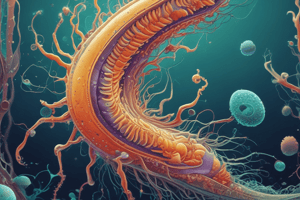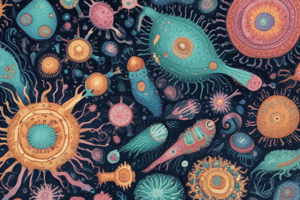Podcast
Questions and Answers
What is the characteristic feature of the supergroup Excavates?
What is the characteristic feature of the supergroup Excavates?
- The presence of a modified mitochondria
- The presence of a nucleus in all members
- The presence of a spiral or crystalline rod in their flagella
- The presence of a feeding groove in some members (correct)
What is the characteristic of the mitochondria in Diplomonads?
What is the characteristic of the mitochondria in Diplomonads?
- They are present in all forms
- They are modified to form mitosomes (correct)
- They are modified to form hydrogenosomes
- They are absent in all Diplomonads
Which of the following is a pathogenic parasite that causes vaginitis in women and urethritis in men?
Which of the following is a pathogenic parasite that causes vaginitis in women and urethritis in men?
- Trichomonas vaginalis (correct)
- Euglenozoa
- Giardia intestinalis
- Trypanosomes
What is the transmission method of Giardia intestinalis?
What is the transmission method of Giardia intestinalis?
What is the characteristic of the flagella in Euglenozoans?
What is the characteristic of the flagella in Euglenozoans?
Which of the following is a characteristic of Trichomonas vaginalis?
Which of the following is a characteristic of Trichomonas vaginalis?
What is the size of Trichomonas vaginalis?
What is the size of Trichomonas vaginalis?
Which of the following is a kinetoplastid?
Which of the following is a kinetoplastid?
What is the disease caused by Giardia intestinalis?
What is the disease caused by Giardia intestinalis?
What is a characteristic of Apicomplexans?
What is a characteristic of Apicomplexans?
What is the primary mode of transmission of Plasmodium malariae?
What is the primary mode of transmission of Plasmodium malariae?
What is the result of natural selection favoring the survival of thalassaemia allele carriers in areas with high prevalence of malaria?
What is the result of natural selection favoring the survival of thalassaemia allele carriers in areas with high prevalence of malaria?
What is the approximate number of deaths per year caused by malaria?
What is the approximate number of deaths per year caused by malaria?
In what stage of the Plasmodium lifecycle does haemoglobin digestion occur?
In what stage of the Plasmodium lifecycle does haemoglobin digestion occur?
What is the primary function of Sporozoites?
What is the primary function of Sporozoites?
What is the result of Toxoplasma gondii infection in a fetus?
What is the result of Toxoplasma gondii infection in a fetus?
How is Toxoplasma gondii typically transmitted?
How is Toxoplasma gondii typically transmitted?
What is the ploidy of the zygote stage in the Plasmodium lifecycle?
What is the ploidy of the zygote stage in the Plasmodium lifecycle?
What is the primary function of the cilia in ciliates?
What is the primary function of the cilia in ciliates?
Which of the following groups is characterized by the presence of smooth or hairy flagella?
Which of the following groups is characterized by the presence of smooth or hairy flagella?
What is the primary function of the contractile vacuole in ciliates?
What is the primary function of the contractile vacuole in ciliates?
Which of the following groups includes both dinoflagellates and diatoms?
Which of the following groups includes both dinoflagellates and diatoms?
What is the primary function of the pseudopodia in rhizarians?
What is the primary function of the pseudopodia in rhizarians?
Which of the following organisms is a decomposer?
Which of the following organisms is a decomposer?
What is the primary function of the food vacuoles in ciliates?
What is the primary function of the food vacuoles in ciliates?
Which of the following groups includes golden algae and brown algae?
Which of the following groups includes golden algae and brown algae?
What is the primary function of the micronucleus in ciliates?
What is the primary function of the micronucleus in ciliates?
What is the characteristic pigment responsible for the red colour in red algae?
What is the characteristic pigment responsible for the red colour in red algae?
Which of the following is a colonial freshwater green alga?
Which of the following is a colonial freshwater green alga?
What is the name of the seaweed that belongs to the red algae group?
What is the name of the seaweed that belongs to the red algae group?
Which group of organisms includes animals, fungi, and two protist groups?
Which group of organisms includes animals, fungi, and two protist groups?
What is the name of the intertidal chlorophyte?
What is the name of the intertidal chlorophyte?
Which of the following is a type of green algae?
Which of the following is a type of green algae?
What is the characteristic shape of the pseudopodia in Amoebozoans?
What is the characteristic shape of the pseudopodia in Amoebozoans?
Which group of organisms includes slime molds and Gymnamoebas?
Which group of organisms includes slime molds and Gymnamoebas?
What is the name of the species of red algae that is commonly found in tropical seaweeds?
What is the name of the species of red algae that is commonly found in tropical seaweeds?
Which protist group is responsible for digesting cellulose in the gut of termites?
Which protist group is responsible for digesting cellulose in the gut of termites?
What is the primary role of photosynthetic protists in aquatic environments?
What is the primary role of photosynthetic protists in aquatic environments?
Which of the following protists is known to cause keratitis and encephalitis?
Which of the following protists is known to cause keratitis and encephalitis?
What is the primary group classification of Entamoeba histolytica?
What is the primary group classification of Entamoeba histolytica?
Which supergroup does the protist Trypanosoma brucei belong to?
Which supergroup does the protist Trypanosoma brucei belong to?
What is the disease caused by the protist Plasmodium malariae?
What is the disease caused by the protist Plasmodium malariae?
Which of the following protists is a symbiotic partner in the development of coral reefs?
Which of the following protists is a symbiotic partner in the development of coral reefs?
Which eukaryotic supergroup does the protist Giardia intestinalis belong to?
Which eukaryotic supergroup does the protist Giardia intestinalis belong to?
What is the primary way in which protists contribute to ecological communities?
What is the primary way in which protists contribute to ecological communities?
Study Notes
Apicomplexans
- Apicomplexans are pathogenic parasites that cause serious human diseases, and they require 2 or more different host species to complete their life cycle.
- Examples of pathogenic species include Plasmodium malariae, which causes malaria, and Toxoplasma gondii, which causes toxoplasmosis.
Plasmodium malariae
- Plasmodium malariae is a pathogenic species that causes malaria.
- Transmission occurs through mosquitoes.
- Reproduction in red blood cells involves haemoglobin digestion.
- Natural selection favored the survival of thalassaemia allele carriers (heterozygotes) in areas with high prevalence of malaria.
- There are ongoing efforts for vaccine development.
Toxoplasma gondii
- Toxoplasma gondii is a pathogenic species that causes toxoplasmosis.
- Transmission occurs through the oral-faecal route, by consuming contaminated raw or undercooked meat, or by ingesting anything contaminated with cat or other animal faeces.
- Trans-placental transmission can occur from mother to fetus, causing abortion, hydrocephalus, or mental retardation of the fetus.
Supergroup Excavates
- The supergroup Excavates is characterized by the presence of a feeding groove in some members.
- Subgroups include Diplomonads, Parabasalids, and Euglenozoans.
Diplomonads
- Diplomonads are flagellated protozoa with modified mitochondria (mitosomes).
- Giardia intestinalis is a diplomonad parasite that causes gastroenteritis (food poisoning) through food-borne transmission.
Parabasalids
- Parabasalids are flagellated protozoa with modified mitochondria (hydrogenosomes).
- Trichomonas vaginalis is a parabasalid parasite that causes vaginitis in women and urethritis in men through sexual transmission.
Euglenozoans
- Euglenozoans are characterized by the presence of a spiral or crystalline rod inside their flagella.
- Kinetoplastids, including Trypanosoma brucei and Trypanosoma cruzi, are Euglenozoans that cause African trypanosomiasis (sleeping disease) and American trypanosomiasis (Chagas' disease), respectively.
SAR Clade
- The SAR clade includes several protist groups, including Stramenopiles, Alveolates, and Rhizarians.
- Apicomplexans, including Plasmodium malariae and Toxoplasma gondii, are part of the Alveolate group.
Protists in Ecological Communities
- Symbiotic protists, such as dinoflagellates, play a role in the development of coral reefs.
- Wood-digesting protists digest cellulose in the gut of termites.
- Photosynthetic protists are major energy producers in aquatic environments.
- Pathogenic protists, such as Plasmodium malariae and Pfiesteria shumwayae, can cause diseases and fish kills.
Classification of Eukaryotes
- Eukaryotes are divided into several supergroups, including Excavates, SAR, Archaeplastids, and Unikonts.
- Each supergroup includes several protist groups, as well as fungi and animals.
Human Pathogenic Protists
- Several protist groups can cause human diseases, including Diplomonads (Giardia intestinalis), Parabasalids (Trichomonas vaginalis), Euglenozoans (Trypanosoma brucei and Trypanosoma cruzi), Apicomplexans (Plasmodium malariae and Toxoplasma gondii), and Amoebozoans (Entamoeba histolytica and Acanthamoeba).
Studying That Suits You
Use AI to generate personalized quizzes and flashcards to suit your learning preferences.
Description
Learn about the supergroup Excavates, its characteristics, and its subgroups, including Diplomonads, Parabasalids, and Euglenozoans. Discover the unique features of these protozoa and their pathogenic effects.




